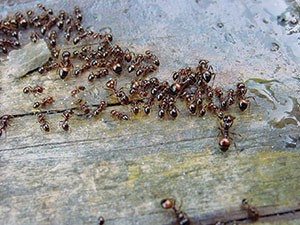
These red imported fire ant workers (Solenopsis invicta) exploit spilled grease as a food resource. Photo: Mark Sheperdigian
The ants you see aren’t the problem. They’re only a symptom. The real problem is the colony constantly producing more ants.
Place bait where the ants are looking for food. Use enough bait to do the job.
As a pest management skill, baiting ants differs radically from baiting most other pests because you’re typically on your own, even though the ants are all in it together. Baiting for cockroaches is like feeding dogs — separate dishes for everyone keeps them from fighting for the food. Baiting birds means you show up at the same time with the same food every day. However, these strategies do not translate into successful ant control.
Ants work together as a household, biologically committed to making their colony successful. They search for a large food source and use teamwork to move it back to the colony. There are basic principles to follow for successfully baiting ants. Two of my favorites are:
1. While you’re at work, most of the ants are at home.
In practical terms, this means even if you eliminate all the ants you see, you can’t beat them. They’ll just produce more ants. Across the species of pest ants, only 5 percent to 20 percent of the colony goes out into the dangerous world to forage for food. Everyone else works from home. If you can’t reach out and touch the colony at home, you’ll lose this battle.
2. Ants work hard to feed the colony. Don’t make them work any harder.
There are many activities for which ants are perfectly equipped. The most visible of activities is foraging for food. They have complex behaviors that enable them to find food sources and efficiently transport food to the colony.
Consider the multitude of dangers foraging ants face, and the relatively huge amount of food they must supply to support the colony. Each ant has to procure sufficient food to feed itself and another dozen ants back home. They must accomplish this feat without becoming prey to a host of predators, including spiders. (I wonder whether ants are arachnophobic? I guess it’s not a phobia if the fear is rational.)
Place ant baits where the ants want their food to be. Look for areas of activity and use plenty of bait there. If you put out too little bait, they’ll finish it and move on to other food.
For effective and efficient ant baiting, find the areas where ant foragers are looking, and make their day by supplying a plentiful supply that will trigger their natural instincts.
You can reach Mark Sheperdigian, BCE, at shep@rosepest.com.
Leave A Comment